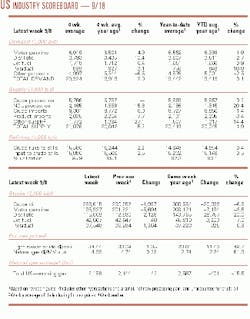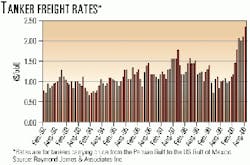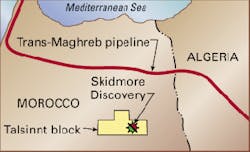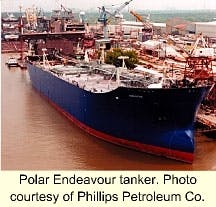OGJ Newsletter
Market Movement
OPEC production boost: enough to quell prices?
For the third time this year, OPEC has agreed to boost production, but there is near-unanimity that the volumes offered won't suffice in the near term (see Editorial, related story on p. 28, and Watching the World, p. 29).
After concerted international pressure, OPEC-excluding Iraq-agreed at a meeting in Vienna last week to hike output by 800,000 b/d starting in October and agreed to revist the issue at a Nov. 12 meeting.
Crude oil futures spiked sharply in the wake of the meeting, as the market deemed the pledged volume increase insufficient, with NYMEX October crude closing at $35.14, up $1.51 on the day.
Following the conference, OPEC Pres. Alí Rodríguez Araque assured that the group could raise output by a further 2 million b/d, if "needed" by the market.
Rodriguez reiterated that the organization is "committed to bringing crude oil prices into the range of $22-28 / bbl," OPEC News Agency reported. Rodriguez maintains that prices will be driven down into that range by the October output increase "within the next few months."
Those comments, plus profit-taking, pulled the NYMEX October contract back down to just below $34/bbl in early trading Sept. 14.
API: US crude production slump continues
The US posted increases in almost all petroleum-related production, delivery, and inventory categories in August, said API, with the exception of US crude production and stocks, which fell for the month.
US production of distillate, used for heating oil and diesel fuel, was a record 3.707 million b/d in August. The previous US record was set during the bitter winter of 1977.
API said August distillate output was 8.4% higher than a year ago and roughly equaled August deliveries of 3.740 million b/d, an 8.8% increase over last year.
Deliveries of high-sulfur distillate, used for residential and commercial heating, increased 22% to 1.104 million b/d. API attributed that to heating oil dealers and electric utilities stocking up for the winter.
"While distillate stocks increased by 1 million bbl from July to August, total inventories of 112.9 million bbl of the fuel were still 20% lower than last August," said API. "These stocks have grown at a slower rate than usual."
However, API said current inventories are about 30 million bbl above the operating level that the National Petroleum Council has estimated the US distribution system needs in order to operate smoothly.
US crude production was down 0.2% at 5.767 million b/d. For the eighth time in the last 9 months, production in the Lower 48 states (4.854 million b/d) exceeded year-ago levels. Alaskan production fell 9.7% to 913,000 b/d last month.
US crude oil imports were 4.1% higher at 9.271 million b/d and set a record for August. Taking into account imported refined products of 11.310 million b/d, imports represented 56% of US oil consumption (down from 60% earlier in the year) last month. Crude oil stocks were down 8.3% at 289.1 million.
November: the month to watch for gas
With natural gas futures contracts trading for more than $5/Mcf, analysts say November will be the month to watch, now that summer demand is passing its peak.
If it appears the weather will be warmer than normal, "we could see prices pulling back" from the $5 level, said Michael Schmitz, an analyst with SalomonSmithBarney. But if it turns colder, gas prices could spike even higher, he says, with gas storage still at a low level.
"People are starting to realize there's only 10 weeks left in the storage season," he said, and "they are running out of time." Moreover, deliverability is still down, pressuring prices higher. NYMEX October gas closed at $5.055/Mcf Sept. 13.
Lehman Bros. analysts Thomas R. Driscoll and Jeffrey Robertson are projecting natural gas prices could surge to $6-7/MMbtu, potentially forcing inter-fuel competition with more-expensive No. 2 heating oil.
They say high prices have already hurt demand, reducing consumption by an estimated 2 bcfd in June, July, and August.
"We believe that a decrease in demand resulted from higher prices and freed up an additional 2-3 bcfd that was then injected into storage," the Lehman Bros. analysts said.
null
null
null
Industry Trends
Oil transporT capacity limitations will be the main driver behind high oil prices over the coming year-not OPEC production changes and limitations-says Raymond James & Associates.
"While everyone's attention has been focused on OPEC production changes as the key driver of world oil prices," the analyst said, "we believe global oil shipping capacity has quietly emerged as the real oil price driver over the next year.
"In other words, the bottleneck in the oil supply chain will first occur in the oil tanker market, rather than [with] OPEC oil wells," said the analyst.
In actuality, the analyst contends that this bottleneck has already begun to affect global crude supplies, given that the world's tanker fleet utilization rate has crested in recent months, which can ultimately affect the oil supply-demand equation.
"One only has to look at tanker [freight] pricing ends over the past year to see that oil tanker demand is already outstripping tanker supply," Raymond James said (see chart).
Natural gas demand is on the rise in Asia, after being restrained for 2 years as a result of the economic crisis in the region, according to Petronas CEO Mohamed Hassan Marican.
In an address at Gasex 2000, a natural gas conference and exhibition in Pattaya, Thailand, last week, Marican noted that the strong growth projected in electricity consumption in the recovering economies of the Asia-Pacific region is a key reason for rising gas demand.
The Association of Southeast Asian Nations (ASEAN) region alone is expected to require an additional 70,000 Mw of power generation capacity by the end of the decade, Marican said, pointing out that it was the power sector that drove the strong growth in Asian gas consumption during the past decade.
"The power sector is expected to continue strong expansion of the regional economies," he said, highlighting another wave of new gas demand in the region.
Given Asia's need for natural gas, especially in the new markets of India and China, Marican called on gas suppliers in the Middle East and East Asia to explore mutually beneficial trade or "cooperative competition" to optimize the potential that can be derived from the rebirth of Asia's gas market. Affordability of gas in these new markets is a key concern, he said.
Government Developments
DOE has its first takers on heating oil storage in the US Northeast.
DOE last week accepted the bids of two companies offering to store a total of 2 million bbl in Connecticut and New Jersey.
Pres. Clinton had ordered DOE to establish a temporary heating oil reserve in the US Northeast and asked Congress for legislation to make it permanent.
Morgan Stanley Capital Group will supply and store 1 million bbl at Amerada Hess's First Reserve Terminal at Woodbridge, NJ. Transfer will be made in October to the terminal, which is on the Raritan River near Perth Amboy, NJ.
Equiva Trading will provide the other 1 million bbl of distillate for two New Haven, Conn., sites. Half will be stored at the Motiva terminal, which Equiva operates, and half at the Wyatt terminal, which Morgan Stanley Capital Group leases. Both terminals serve New England via tankers, barges, tank trucks, and pipelines.
The companies were selected in a competitive process conducted by the Defense Energy Support Center, the fuel purchasing arm of the Defense Department.
Blockades by truckers, farmers, and fishermen that began in France earlier this month over escalating fuel prices spread to the UK, Germany, Belgium, and the Netherlands last week.
OPEC's collective decision to boost oil production by 800,000 b/d apparently has done little to appease the ire of these groups-and others whose profitability depends heavily on fuel prices, such as taxi drivers and tour operators-over high fuel prices in the EU.
British Prime Minister Tony Blair and German Transport Minister Reinhard Klimmt said their countries would not follow the example set by France, which yielded to demands to subsidize fuel prices (OGJ Online, Sept. 5, 2000). Protests have continued in several French cities since the government announced its concessions.
Protesters in Britain blocked fuel shipments out of six refineries, BBC reported, including two in the South Killingholme area: Conoco's 180,000 b/d refinery and Lindsey Oil Refinery's 192,000 b/d plant. Late last week, Blair had ordered the blockades broken, as tanker trucks began carrying fuel from refineries and terminals under police escort.
In Belgium, protesters impeded traffic in the center of Brussels and blockaded the country's largest refinery. Talks between the Belgian transport minister and drivers continued, with both sides still refusing to back down at presstime.
The push to ban mtbe in the us gathers steam.
The US Senate environment and public works committee last week approved a bill banning MTBE from gasoline and mandating the use of ethanol.
The compromise bill would eliminate use of MTBE in reformulated gasoline (RFG) within 4 years or allow EPA to ban it sooner. State governors could waive the 2 wt % requirement for oxygen in RFG.
The bill would require more use of alternate fuels-including ethanol-by setting a minimum content for "renewable" fuels in all motor fuels sold. The level would start at 0.6% in 2002, rising a tenth of a percentage point yearly to 1.5% in 2011.
NPRA strongly opposes the bill, saying US refiners are already "stretched to the limit meeting consumer demand and current environmental requirements."
Quick Takes
A Texas independent has an oil and gas strike in Morocco.
Skidmore Energy said that its Moroccan affiliate Lone Star Energy drilled a discovery well on Block 3 of the Talsinnt Permit in Morocco's High Plateau basin (see map).
The SBK-1 well is on the western edge of the High Plateau basin about 100 miles south-southwest of Oujda and 60 miles west of Morocco's border with Algeria. The SBK-1 well on the Sidi Belkacem prospect "confirms the petroleum system and the potential of the Triassic and Jurassic age sediments on the northern flank of the Atlas Mountains," said Skidmore Pres. John Sobehrad.
The company said the well encountered Triassic TAGI, its primary target, at 3,425-3,505 m. A drill stem test indicates a reservoir pressure of 7,175 psi and a production rate of 2.5 MMcfd, with minor amounts of light oil.
Skidmore gave no TD but said the firm is drilling a developmental sidetrack to confirm reservoir extent and expedite placing the well on production. Lone Star, which holds interest in three onshore and two shelf blocks in Morocco, hopes to drill two offshore and five land wells.
In other exploration action, Gulf Canada Resources made two natural gas discoveries, one on P9 block in the Dutch North Sea and the second in Canada. Off the Netherlands, the P9-9 well flowed 11 MMcfd of gas from a 10-m perforated interval. Gulf Canada holds a 56.4% interest in this well through its subsidiary Clyde Petroleum Exploratie. Partners in the P9-9 well include Erdol-Erdgas Gommern Netherlands, 19.9%; Dyas, 19%; and Holland Sea Search, 4.7%. In the Musreau region of northwestern Alberta, Gulf Canada started production from the Chicken 3-21 discovery. The Chicken 3-21-61-7w6 well, drilled to 5,034 m TD and tested and tied into a nearby gas processing plant, is producing 11 MMcfd of gas. Operator Gulf holds a 60% working interest in the Chicken 3-21 field.
Cabot Oil & Gas recently hooked up two of its operated discoveries in Louisiana, Augen and Bon Ton, in which Cabot has a 50% working interest. The wells are producing more than 38 MMcfed combined, or 13.3 MMcfed net to Cabot. Each well is producing at a gross rate of more than 17 MMcfd of gas. The Augen well is also producing 247 b/d of oil (gross) with 8,600 psi flowing tubing pressure, and Bon Ton is producing 345 b/d of oil (gross) with 6,150 psi flowing tubing pressure.
After drilling the Llano No. 3 well, EEX is relocating the Glomar Arctic I semi to nearby Garden Banks Block 344 in the Gulf of Mexico to test the Jason prospect, 6 miles northeast of the Llano find. The first exploratory well is expected to take 90 days to drill and will target Lower Pliocene and Miocene sands down to 18,000 ft. Operator EEX has a 60% working interest in the block through the Pliocene base and a 30% interest in deeper intervals. ExxonMobil has a 40% interest in both intervals. The well is subject to a JV agreement with Enterprise Oil under which EEX will be carried for a 30% working interest in the sub-Pliocene interval.
Algeria will soon launch a tender offer for hydrocarbon exploration concessions. This will be the country's first open licensing round. Energy and Mines Minister Chakib Khelil, in an interview with the State News Agency, noted that the licensing round approach "would avoid the slowness of discussions" usual in the negotiation of this kind of contract. The operation would also be used as a litmus test of prospects for a proposed law on hydrocarbons now being studied prior to submission to the Algerian energy council for final approval, he said. No details were given on the concessions to be offered.
BP has quickened the pace of the UK North Sea's recovery.
The major has awarded the high-status, front-end engineering design contract for its $750 million Atlantic Margin Clair development to Wood Group's US subsidiary Mustang Engineering.
The deal-which is targeted to cement a development plan that could be put before the field partners next summer and move Clair toward first oil by 2004-is worth some $5 million to Mustang, which was last month taken over by Aberdeen-based Wood Group (OGJ Online, Aug. 4, 2000).
Current development plans, centering on the 250-million bbl Clair South reservoir, are understood to favor a conventional fixed platform for the deepwater field, with oil being transported by pipeline to Scotland's Sullom Voe or Flotta terminal.
BP expects its initial outlay at Clair to be eclipsed by a life-of-field investment of about $1.5 billion. Wood Group said detailed design work would begin in third quarter 2001, with construction to begin in 2002.
NORM management has reached cyberspace.
US DOE and IOGCC have established an internet page (www.iogcc.state.ok.us/NORM) to help oil and gas field operators manage naturally occurring radioactive materials (NORM).
DOE said, "The presence of NORM in concentrations that exceed natural background levels may present a potential human health risk."
The NORM Technology Connection website provides data on NORM regulations, including a directory of state regulatory agencies and rules. It also has a discussion forum. It includes a database on service companies that provide site characterization and remediation support, sample collection and analysis, equipment cleaning and reconditioning, radiation safety program development, radiation safety and training, NORM waste treatment and disposal, and general consulting.
In further production news, Suncor plans to spend $13-22 million (Can.) as its share of a project to resolve operational issues at its $250 million Stuart JV oil shale demonstration project in Australia. The project will be put on hold until concerns about environmental and social impacts are addressed, said Suncor. In addition, the company agreed to an after-tax writedown of $80 million (Can.) on the project, reflecting increased costs and delayed oil production. The plant upgrades could take until April 2001 to complete. Suncor anticipates that, once commissioning is finished, the company could need an additional 6-9 months of operational experience to demonstrate the technology before making longer-term investment decisions.
Chevron and NNPC are eyeing liquids from Nigerian natural gas.
In hopes of reducing significantly the amount of gas being flared in their Nigerian JV operations, Chevron and NNPC will invest $2 billion in two projects-the Escravos Gas Project Phase 3 and the Escravos GTL development-both of which are targeted for completion in 2005.
The Escravos GTL facilities will combine technology from Sasol and Chevron. (Sasol and Chevron formed a global GTL alliance last year.) Chevron and NNPC will build these projects adjacent to the joint venture's existing operations at Escravos (OGJ, July 31, 2000, p. 17).
The Escravos gas project's third phase will process 400 MMcfd of gas that is currently produced along with crude oil and flared. The plant will extract about 15,000 b/d of NGL and prepare the natural gas for use as feedstock for the Escravos GTL facilities, which will produce about 33,000 b/d of liquid fuels to be marketed primarily in Europe.
Sasol and Chevron announced plans in June 1999 to create a global JV company to develop, implement, and operate GTL ventures and market their products (OGJ, June 14, 1999, p. 30). A formal decision to form the venture is expected soon, says Chevron.
In other gas processing news, Propak Systems completed an $85 million sour gas and oil processing plant in western Poland for Polish Oil & Gas. The plant will yield 8,300 b/d of oil, 400 b/d of stabilized condensate, 800 b/d of LPG, 130 tonnes/day of sulfur, and 45 MMscfd of residue gas. The project was placed in operation in March. "The plant residue gas will be utilized in the first electrical power generating plant in Poland using natural gas versus coal as the source of fuel," said the company.
INDIA IS SELLING FOUR OF ITS REFINERIES WITH HOPES OF FUTURE PRIVATIZATION.
India will part with four stand-alone refineries to state firms IOC and Bharat Petroleum Co. Ltd. (BPCL) for an estimated 18 billion rupees ($393 million).
The transaction will likely make the two public-sector firms stronger and ensure that they fetch more when the government privatizes them.
According to Petroleum Minister Ram Naik, IOC would take over the 130,000 b/d Chennai (formerly Madras) refinery, where the government has a 52.5% stake worth 6.0138 billion rupees. IOC will also take over the 27,000 b/d Bongaigon refinery, where the government's equity of 74.46% is worth an estimated 4.6097 billion rupees.
BPCL will take over the 150,000 b/d Kochi (formerly Cochin) refinery in Kerala, where the government has a 55.04% stake worth 7.0115 billion rupees, and its 19% equity (1.730 billion rupees) in the 60,000 b/d Numaligarh refinery in Assam. The restructuring will be completed by 2002.
Three new-generation tankers are being built for alaskaN trade.
Polar Tankers-the shipping unit of Phillips Alaska-said that Litton/Avondale Industries laid the keel of the MV Polar Discovery, the third Millennium-class tanker being built to carry crude oil from Alaska to the US West Coast.
These double-hulled tankers are built specifically for Alaskan trade, in compliance with the US Oil Pollution Act of 1990, Polar said, adding that the tankers cost $150 million apiece to build.
Polar Discovery will hold just over 1 million bbl of cargo at full capacity. The tanker will be delivered in late 2002. The first of the Millennium-class tankers, the Polar Endeavour, will enter the Alaska trade in early 2001, Polar said.
The start-up of Statoil's new Norne-Heidrun gas pipeline system in the Norwegian Sea has been postponed to Nov. 15 from Oct. 1.
The delay stems from the late arrival of Saipem's Maxita crane ship from Royal Dutch/Shell's nearby Draugen field. Statoil was scheduled to receive the vessel in July.
Norne is due to start exporting gas in order to optimize oil production, using a pipeline extending south 128 km to tie into Statoil's Åsgard transport trunkline. Heidrun gas is linked by a 39-km line into the Åsgard trunkline, which extends to the Karstøø treatment plant north of Stavanger.
The Maxita will install modules containing safety valves at the points of tie-in with the Norne production ship and the trunkline.
Including conversion work on the ship, the Norne export line has cost about 1.2 billion kroner. It is expected to carry 1 billion cu m/year of gas. The Heidrun part of the system cost $334 million and should transport roughly 75 million cu m/year.
Rounding out pipeline action, Sonatrach and Cepsa signed an agreement to set up a JV to conduct a feasibility study on a third gas pipeline that would link Algeria with Europe. The proposed 450-km line would begin in the port city of Beni Saf, in northwest Algeria, and terminate in Almeira, in southern Spain. Sonatrach said that, over the last decade, the region had seen annual gas demand rising from 135 billion cu m (bcm) at the beginning of the 1990s to 270 bcm now. Algeria is already linked to Europe by two other gas pipelines. The first line, on stream since 1966, provides Morocco, Spain, and Portugal with about 10 bcm/year of gas. The second, in operation since 1983, supplies about 20 bcm/year of gas to Italy via Tunisia.
Nigeria said the Niger Delta states must crack down on vandalism of petroleum product pipelines. If police are not able to do the job, the military will step in, said the government, which issued the ultimatum in response to the loss of more than 600 lives and $40 million due to petroleum product pipeline vandalism this year. The government's decision was handed down at the end of a national emergency security meeting, chaired by Nigerian Vice-Pres. Atiku Abubakar. The affected states are required to set up independent monitoring teams to crack down on vandalism. The states also must embark on "enlightenment" campaigns aimed at educating the public about the adverse effects of pipeline vandalism on the nation's economy.



